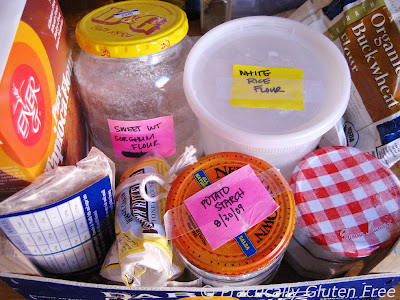Q: What flours do you rely on?
Before I embark on my baking recipes (I do actually bake, though you wouldn't know it from the blog so far), I wanted to provide a little background on gluten free flours first. One of the scariest parts of the diet transition for me was cracking open a recipe book and seeing "amaranth flour" or "quinoa flakes" as an ingredient...what is a "quinoa" and why does it flake? Why does "amaranth" sound like a mumble? Many questions.
It's a learning process. Luckily for me, there were plenty of internet resources that do a fine job of explaining. The rest is really just trial-and-error, and after awhile, you'll get an idea of which flour produces a particular result, and which you like the best. If you're not gluten free and following this blog as a personal favor to me (I owe you one), maybe consider shaking things up a bit and giving these flours a try.
Instead of reinventing the floury wheel, I'd rather list a few good resources for you to check out and bookmark, then add a few tips and personal preferences.
A Few Good Sites
PCC Natural Market's guide, complete with a downloadable brochure
Gluten Free Mommy's superb guide, with pictures and tips
Triumph Dining's guide, including some facts and context for the flours
If there's anything to add to these great lists, it's a few tips of my own, garnered solely through experience:
- If you're usually in a rush to bake, or don't have patience to measure out multiple different types of flour, buy a good all-purpose gluten free baking mix (often marketed as a "Baking and Pancake Mix"). Authentic Foods, King Arthur, Arrowhead Mills, Pamela's, and a host of other companies sell these. They typically include a blend of flours, plus a gum for hold, plus sometimes a self-rising agent like baking soda. Just be sure to read the ingredients carefully - and make sure it's gluten free! Later on, when you're more comfortable with baking, think about developing your own mix (more on that to come).
- I hate bean flours! I just do. They taste like a battery to me. Not that I would know what a battery tastes like, but I can imagine. Back in the early days, I used a chocolate chip cookie mix comprised primarily of bean flours, and I thought I contaminated the batch. Sir Benjamin wouldn't even eat them. Apparently, adding extra sweetener to balance the metallic taste can be effective, and/or some people don't notice it, but with all the available varieties of flours out there, I can't imagine why you'd choose a bean flour. Be careful, too, because many all-purpose flours include bean flours (garbanzo/chick pea and fava seem to be the most popular).
- The best combo of flours, in my opinion, contains the largest variety. I've used up to five different flours in one recipe, which sounds like a pain in the rear, but once you have them on-hand it's not that big of a deal. Sorghum - brown rice - cornstarch - potato flour - tapioca flour make a delicious combo for a light but sturdy hamburger roll (soon!).
- In most recipes, a thickener and/or binding agent, like xanthan gum, flaxseed, or the hot new chia seeds are needed. Dense recipes, like brownies, that use eggs or a flaxseed and water combo don't really need a binder, but breads, pancakes, muffins, and cookies often do. Xanthan gum may seem expensive, but the $11 bag I bought over a year ago is still going strong.
- My very favorites are sorghum (a sweet, hearty flour that mimics a light whole wheat flour), buckwheat (an earthy flavor that's awesome in pancakes and muffins), tapioca starch (a featherlight starch that contributes to a lighter, springy texture when used with heavier flours), and superfine sweet white rice flour (light and indispensable in breads, pizza, muffins, and cookies). Quinoa flakes are also great to have on hand and substitute nicely for oats at a 1:1 ratio (and they make a delicious hot cereal). Fine cornmeal or polenta also adds a nice texture and taste to breads and muffins.
So now that we've cleared the air on flours, I feel better, and hopefully you do too. Baking recipes to come.

I like the word "amaranth". It sounds mystical and makes me envision vague and wispy maidens in pseudo-medieval green dresses who are standing round in the rain.
ReplyDeleteOr it should be the bad guy in the new Thundercats movie -- we must fight Amaranth the EVERLIVING!
You're going to ban me from commenting on this blog, aren't you?
No, you earned your stripes with that comment. Proceed.
ReplyDeleteI think Alex has what it takes to be an editor!
ReplyDeletePersonally I just use Pamela's all-purpose flour. It bakes almost everything!! You can get it at Amazon but I get mine at Whole Foods. Here's a link to the website - http://www.pamelasproducts.com/index.html
ReplyDeletePamela's is great - a wonderful blend of ingredients (that doesn't include my dreaded bean flours...!). Thanks for the link!
ReplyDelete